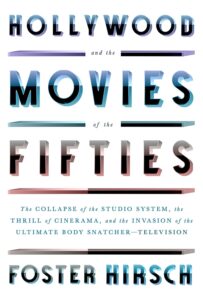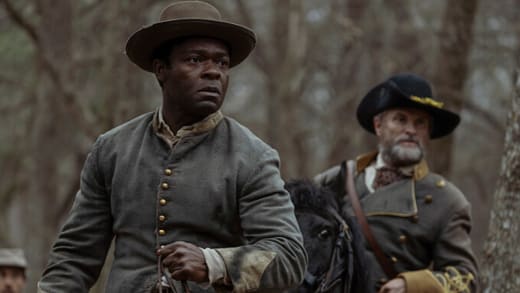In the 1950s, new technologies were the most conspicuous way that the film industry attempted to lure customers. But enlarging the size of the screen, magnifying the soundtrack, and hurling characters and objects into the audience were by no means the only strategies pursued by a business facing financial peril. In the race for survival, new content was as necessary as new formats.
In the postwar decade there was a greater range of subject matter than there ever had been before, and the sheer range and diversity of offerings, from the upper crust to the bottom of the barrel, pinpointed the increasing fragmentation of the audience. Because the studios could no longer rely on multigenerational families of children, parents, and grandparents venturing out for a movie that could be enjoyed by all, they began to tailor their products for viewers of different ages and tastes, a strategy reflected in the era’s steep division between high and low offerings—between “art” cinema of varying kinds on the one hand and the explosion of exploitation fare on the other.
Let’s begin a survey of diversity 1950s style with upmarket fare, a look at the adaptations of literary classics. Paramount presented Tolstoy’s War and Peace (1956); Warner Bros. offered Melville’s Moby Dick (1956) and Hemingway’s The Old Man and the Sea (1958); MGM produced Dostoevsky’s The Brothers Karamazov (1958); 20th Century–Fox released Faulkner’s The Sound and the Fury (1959). Sturdier than their reputations, these valiant upscale attractions are inevitably stunted because, in each, an essential ingredient is missing: the presiding presence of their authors.
Despite the novel’s immense length and its multitude of events and dramatis personae, in some ways the adapters of War and Peace had the easiest job. Tolstoy is a comparatively unobtrusive narrator of a surefire story, in effect a Russian Gone with the Wind. While inevitably sacrificing much of Tolstoy’s political and psychological commentary, the film’s six credited screenwriters—Bridget Boland, Robert Westerby, King Vidor, Mario Camerini, Ennio De Concini, and Ivo Perilli—preserve the essence of Tolstoy’s plot while enrobing it with spectacle. King Vidor’s far-from-deep-enough “translation,” marred by the central miscasting of all-American Henry Fonda speaking in his own untouched midwestern twang as Pierre, Tolstoy’s indelibly Russian protagonist, has a visual majesty that may qualify it as the most elaborate reader’s guide in movie history. The central setting, the manorlike residence of the Rostovs—bursting with people and parties during peacetime, emptied and devastated once war descends—is made for movies, as are a resplendent ball, the cast-of-thousands depiction of the Battle of Borodino, the exodus from Moscow as French forces under Napoleon enter the city, the grueling retreat in the snow of the defeated Napoleon and his army. With its densely detailed long shots and deep-focus clarity, Jack Cardiff’s cinematography is the single finest use of Paramount’s short-lived wide-screen VistaVision format.
Shot entirely on sound stages at a tottering MGM (this was one of the last of the studio’s big made-entirely-in-house productions), The Brothers Karamazov is even less authentically Russian than Paramount’s War and Peace. Nonetheless, this made-in-Hollywood Karamazov cannot be discounted. The screenplay by Julius J. Epstein, Philip G. Epstein, and Richard Brooks, who also directed, reduces Dostoevsky’s dense religious and philosophical discourse into a tightly focused drama about the events leading up to a crime, the killing of the Karamazov patriarch, and the subsequent trial. The screenplay has momentum, and in the climax, the spiritual transformations of the principal characters attain surprising force. Also, Brooks’s film has an ace up its sleeve: the cinematography of Hollywood master John Alton, renowned for his lighting in many film noir thrillers as well as for the ballet sequence, ablaze with the colors of French impressionism, in An American in Paris. Alton bathes The Brothers Karamazov in vibrant shades of red, purple, dark green, and burnt orange, his feverish palette evoking a “dream” of Russian intensity. Alton’s colors turn the opening scenes of Russian dancing and music making, the moments leading up to the murder, the trial scene, and the finale of redemption and transcendence into a film noir en couleur. In 1958, Alton’s over-vivid hues were dismissed as cartoon-like, but over time the Dostoevskian intensity of his approach has been widely praised.
Although American filmmakers might be presumed to be more at ease with native classics than with Russian, home-grown masterworks like Moby Dick and The Old Man and the Sea proved equally untameable movie material. Man faces the sea in starkly allegorical battles in the Melville and Hemingway stories, and try as they do, the films cannot lift the ocean and its creatures to the metaphorical heights they attain in the novels. On film, the sea is the sea is the sea, a whale is a whale is a whale. The screenwriters—science-fiction master Ray Bradbury collaborated with John Huston (who also directed) on Moby Dick; Peter Viertel, who wrote The African Queen, adapted The Old Man and the Sea—were unable to approximate the novels’ symbolic charge. Stripped of most of Melville’s Christian and sexual overtones and of its intimidating whiteness, Moby Dick is simply a mysterious, horror-movie monster the audience waits to see. And when it finally makes its act 3 appearance, it looks like a dated special effect. Although Gregory Peck, who later apologized for his Captain Ahab, claiming he let down the film, is too stolid and self-contained to embody the intensity of Melville’s searcher, he gives what may well be his bravest performance, struggling beyond his depth in the churning waters of Melville’s allegory.
As either spectacle or metaphor, the big fish that we wait for in The Old Man and the Sea is no more convincing than the big white whale. But even if the fish had been rendered with the full resources of contemporary CGI, seeing it would have been redundant, because Hemingway’s self-consciously literary novella about man’s eternal Sisyphean struggle for survival, written in his leanest and most “masculine” style, is meant to be read, or listened to, rather than visualized. Spencer Tracy, speaking in the novella’s third person, reads the old man’s story. He reads it well, with respect for the rhythm and the simplicity of Hemingway’s prose, and without making any attempt to become Hemingway’s Cuban fisherman. Peter Viertel’s screenplay treats Hemingway as holy writ—in 1958 the book was required reading in every high school English class in the country, whereas over time it has come to seem like another generation’s idea of a great book. Along with the solid if plodding direction of John Sturges, their efforts are superfluous—beside the point: a film of The Old Man and the Sea has no reason for being.
Is Faulkner’s distinction between hearing and seeing a possible explanation for why great literature is seldom translated into great filmmaking?
In their screenplay, Irving Ravetch and Harriet Frank Jr. attempt to retrieve from Faulkner’s dense and structurally experimental The Sound and the Fury a realistic linear narrative. They replace the novelist’s technical tour de force, a collage of five narrators, with a conventional story of an aristocratic southern family in decline. And yet there are moments. From time to time, Martin Ritt’s direction conjures an atmosphere of southern torpor and humidity, Yul Brynner is surprisingly persuasive as the patriarch of a crumbling family, and Ethel Waters as the family servant Dilsey (one of the novel’s five narrators) fully evokes the strength of Faulkner’s great character.
In their continuing efforts to link literary prestige with hoped-for financial profit, studios released versions of other (more accessible) works by both Hemingway and Faulkner. The Breaking Point (1950), based on Hemingway’s To Have and Have Not; The Snows of Kilimanjaro (1952), an expansion of a twenty-nine-page story; The Sun Also Rises (1957); and David O. Selznick’s remake of A Farewell to Arms (1957) are of varying quality, but in each case the source material was more movie-friendly than The Old Man and the Sea.
In addition to The Sound and the Fury, there were three other Faulkner adaptations: Intruder in the Dust (1949), The Tarnished Angels (1957), based on Pylon; and The Long Hot Summer (1958), based on the story “Barn Burning,” part of the novel The Hamlet. In his direction of The Tarnished Angels, a story of a war pilot who becomes a circuslike stunt flyer as a way of making money during the Depression, Douglas Sirk takes a forceful approach. With his creative use of lighting, camera movement and placement, and his masterly wide-screen compositions, Sirk in effect becomes Faulkner’s coauthor, translating a literary work into a kinetic, quick-moving movie, one of the director’s baroque melodramas about self-destruction.
“I thought it was pretty good—quite honest,” Faulkner commented about The Tarnished Angels. “But I have to admit I didn’t recognize anything I put into it—the book, not the script.” His favorite adaptation was Intruder in the Dust. “I’m not much of a moviegoer, but I did see that one. I thought it was a fine job. That Juano Hernandez is a fine actor—and man too.” Faulkner worked on the screenplays of about a dozen films, most often for Howard Hawks, but he had an indifferent track record. “I’ve never had much confidence in my capacity as a scenarist,” he admitted. “It ain’t my racket. I can’t see things. I can only hear.” Is Faulkner’s distinction between hearing and seeing a possible explanation for why great literature is seldom translated into great filmmaking? Nonetheless, the flawed attempts throughout the decade to adapt the work of literary masters are noteworthy.
___________________________

Excerpted from Hollywood and the Movies of the Fifties: The Collapse of the Studio System, the Thrill of Cinerama, and the Invasion of the Ultimate Body Snatcher—Television by Foster Hirsch. Copyright (c) 2023 Knopf. Used by arrangement with the Publisher. All rights reserved.

























































